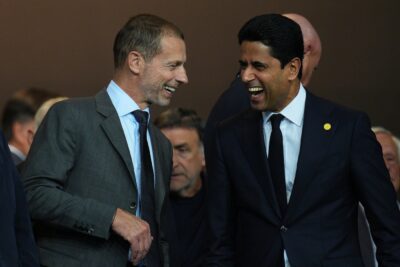European soccer clubs group unveils new name at peak of its powers dealing with UEFA, FIFA
By Canadian Press on October 8, 2025.

ROME (AP) — After 17 years as the European Club Association, the network of hundreds of soccer teams is at peak influence over UEFA in shaping the Champions League – and what might come next for the marquee competition.
So it was time for a name change. From ECA to EFC.
The rebranded European Football Clubs meets in Rome this week at an annual assembly of officials whose collective power negotiating with FIFA and UEFA over elite competitions was never greater.
The ECA was created in 2008 to bring more cooperation, democracy and money to storied teams after their decade of confrontation with international soccer bodies.
There is peace today — restored after the deep rift with UEFA four years ago when an ECA-led group of rebel clubs driven by Real Madrid, Barcelona and Juventus tried, and failed, to launch the breakaway European Super League.
Good relations with European clubs and their chairman, now Nasser al-Khelaifi from Paris Saint-Germain, can seem more important to UEFA and its president, Aleksander Ceferin, than dealing with FIFA. Their contract is signed through 2033.
UEFA, and Ceferin personally, were burned by then-ECA leader Andrea Agnelli plotting the breakaway Super League that was intended for just 20 teams.
“Together with EFC,” Ceferin said Wednesday, “We will make sure that our club football is inclusive and that everybody has a chance to win their best competitions.”
Al-Khelaifi returned the praise.
“I admire the UEFA president because he has got values and courage,” said the clubs’ leader, who also heads Champions League rights holder BeIN Media Group and is a member of Qatar’s government.
History of ECA
It grew out of the G-14 group founded in 1998 by clubs that later formed the Super League core.
They were frustrated at being frozen out of decision-making by FIFA and UEFA who earned billions from the World Cup and European Championship where national teams got free use of club-employed players.
In 2005, G-14 helped directly challenge FIFA in legal action by Belgian club Charleroi, which lost Abdelmajid Oulmers to long-term injury playing with Morocco. It shaped as a test case of clubs absorbing all the risk of releasing players.
When Michel Platini became UEFA president in 2007 talks accelerated to replace G-14 with a broader-based group of clubs. The deal included clubs getting paid from FIFA and UEFA tournament income and ending legal cases.
Club leaders
UEFA and ECA leaderships paired Ballon d’Or winners with a shared World Cup history: Platini and Karl-Heinz Rummenigge, then the Bayern Munich CEO. They steered through the Financial Fair Play monitoring of spiraling spending by clubs who played in UEFA competitions.
“We will cooperate in the future with UEFA, there is no doubt about that,” Rummenigge said in 2016, one year before handing over to Agnelli.
UEFA’s next president was Slovenian lawyer Ceferin who aligned with Agnelli and became godfather to one of his children. Agnelli was steering talks on the new, club-friendly Champions League format while plotting the Super League after the COVID-19 pandemic.
Super League
Persistent rumors fueled leverage over UEFA in regularly scheduled talks to amend Champions League entry rules and prize money formulas — usually favoring wealthy clubs and leagues.
The ECA in March 2009 dismissed Super League rumors “spread by three major European newspapers.” Years later, fresh speculation was dismissed as “a fever dream” by one Italian official.
But there were plans. By UEFA bringing clubs into the house, it had showed them the finances and insight to run their own version.
The project failed within 48 hours amid a backlash from fans and governments. PSG had not joined the rebels and Al-Khelaifi, already seated on UEFA’s executive committee, took over ECA to rebuild its credibility.
Clubs’ achievements
The ECA origin story is getting money from FIFA. That was $40 million from 2010 World Cup revenue, paid per a daily rate to clubs globally whose players went to South Africa.
FIFA will give $355 million from 2026 World Cup income and now will reward hundreds more clubs whose players were selected for all qualifying games.
ECA pushed FIFA to create an insurance fund paying some salary of players injured with national teams. FIFA has budgeted $36 million this year.
National teams no longer have one-game breaks in February and August. FIFA’s match calendar has less long-haul travel for players with fewer international breaks.
Al-Khelaifi also played hardball with FIFA to drive up prize money guarantees for playing in the revamped, $2 billion Club World Cup this year.
Today’s Champions League has 36 teams instead of 32, each playing eight games instead of six, and more against higher-profile opponents. The league phase now has 144 games instead of 96 in the old format shaped by UEFA.
This season’s Champions League prize money fund is nearly 2.5 billion euros ($2.92 billion) compared to 583 million euros ($681 million) in ECA’s debut season.
UEFA’s annual payment toward ECA running costs increased 15-fold from 1.6 million euros ($1.87 million) in 2008 to 25 million euros ($29.2 million) last year as member services increase.
Clubs have since 2017 had two seats on UEFA’s executive committee. Today it is Al-Khelaifi and Miguel Ángel Gil from Atletico Madrid, back in the fold after joining the Super League.
A 2012 renewal of the ECA-UEFA working accord guaranteed “Referral Right” on all club football decisions.
That was used in 2016 — when UEFA had no president — to guarantee four Champions League group-stage entries to highest-ranked nations. That sweetheart deal for England, Spain, Germany and Italy led to lower-ranked nations getting the third-tier Conference League.
UEFA also gave ECA more influence in managing competitions which became a formal commercial joint venture, called UC3. That gave clubs even more say on decisions, including picking United States-based agency Relevent to sell future Champions League broadcast and sponsor deals through 2033.
Future challenges
ECA took no public position on multi-club ownership — investors having stakes in multiple teams — that is widely unpopular with fans and UEFA itself said poses threats to integrity in its competitions and the transfer market.
One MCO debacle involved Florida-based 777 Partners who even got one of its executives on the ECA board representing Standard Liege.
ECA widened its membership base from 250 clubs to around 800 since a rival group, the Union of European Clubs, launched to represent smaller clubs who feel frozen out.
How will the Champions League evolve or be replaced? And will UEFA or the clubs drive that change and organize the next version?
___
Dunbar reported from Geneva
___
AP soccer: https://apnews.com/hub/soccer
Andrew Dampf And Graham Dunbar, The Associated Press
-49




